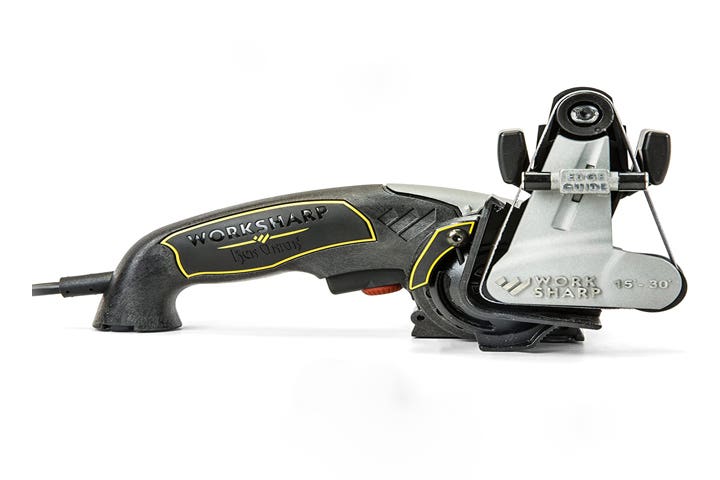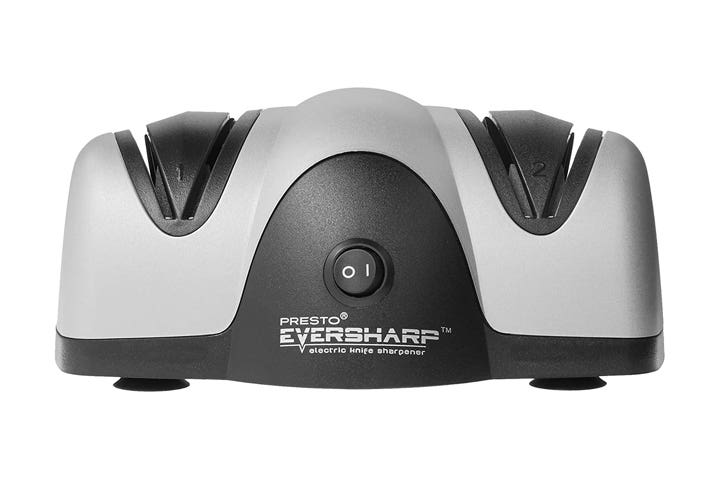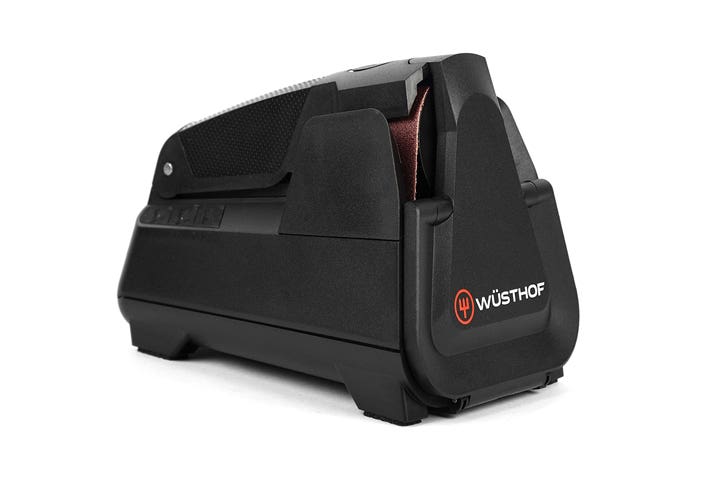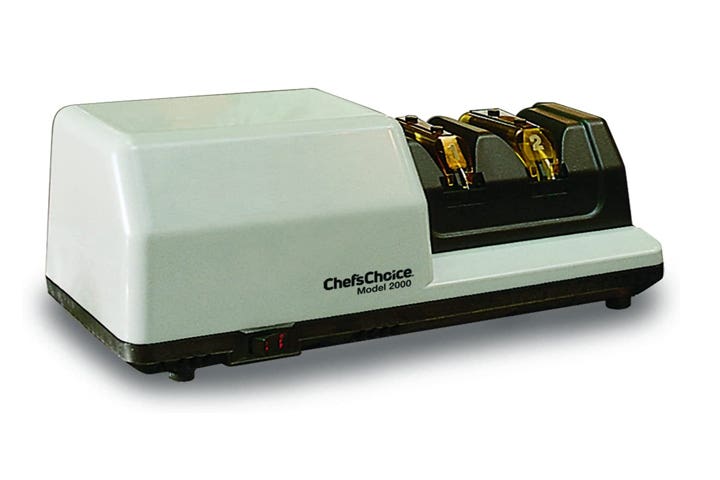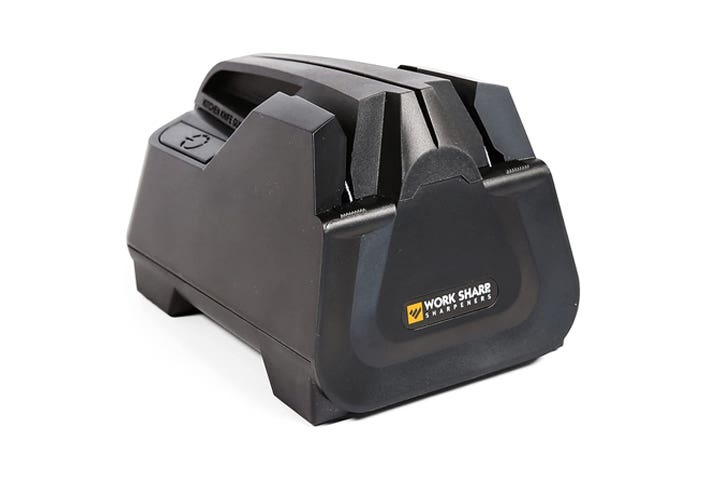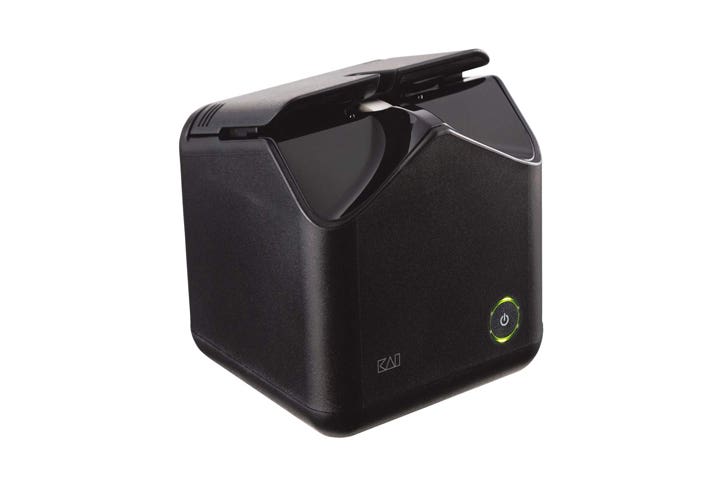The Best Electric Knife Sharpeners For Blades Big and Small
From Japanese knives, to Western knives, to serrated knives, these sharpeners keep them all a cut above.
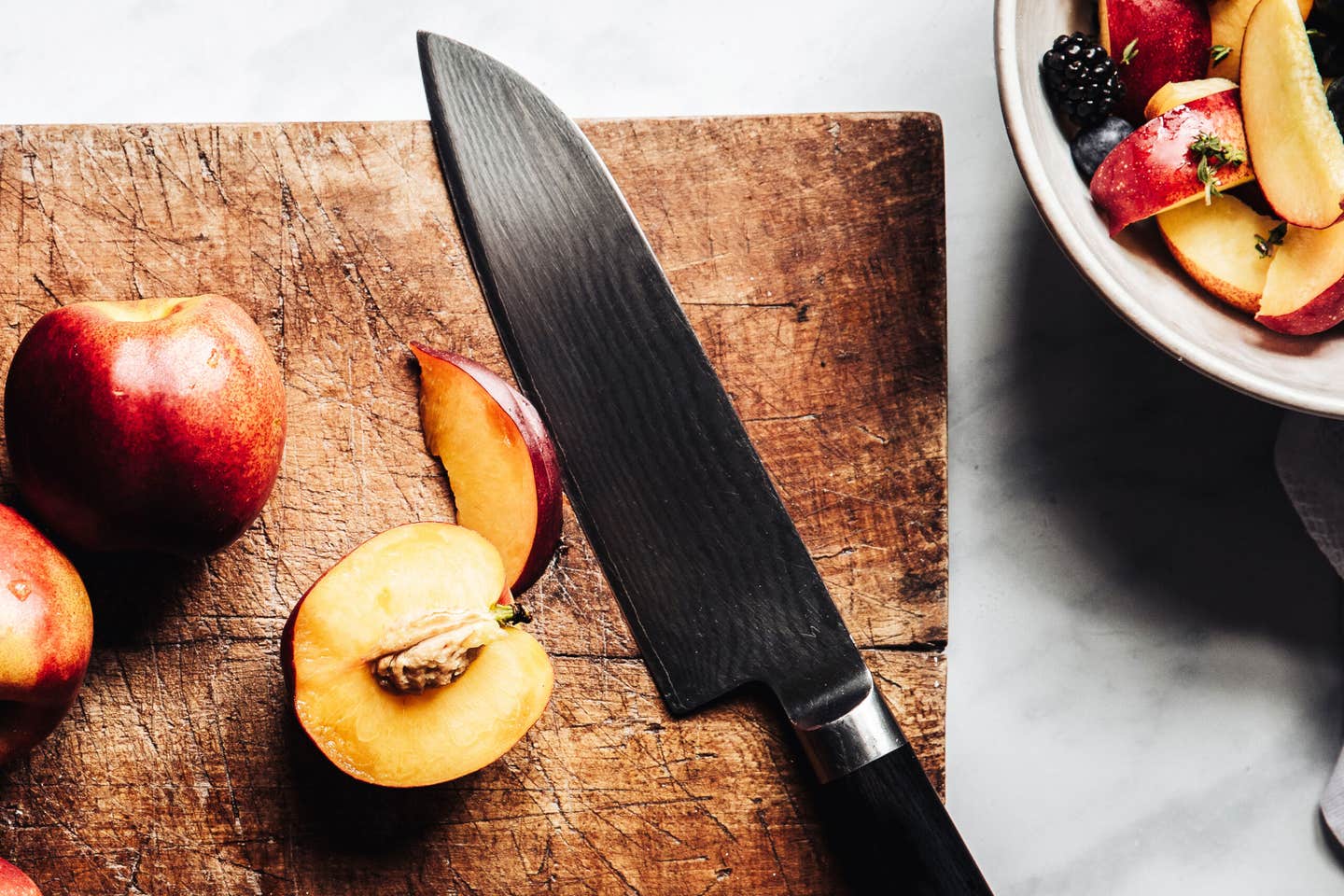
Knives are to a cook what brushes are to a painter. To keep these workhorse kitchen tools in tip top shape, it’s smart to invest in an electric knife sharpener, which takes much of the guesswork and elbow grease out of caring for your blades. They can revive dull knives much quicker than hand-sharpening methods, but it’s also important that these machines are adaptable and nuanced. And yes—it is essential to sharpen your knives every month or two to even out any knicks and restore rolled edges. A sharp knife ensures you won't smush your sourdough or mangle delicate foods like fish and fruit, plus keeps your dinner prep safe, fuss-free, and functional. To make sure we chose sharpeners that treat your knives like a professional would, we also tapped artist, craftsman, and knife expert Geoff Feder of Feder Knives to offer up some insider intel. Keep reading to see our selection of the best electric knife sharpeners, hand selected by our editors.
Our Top Picks
- Best Overall: Work Sharp Culinary Knife & Tool Sharpener Ken Onion Edition
- Best Value: Presto EverSharp Electric Knife Sharpener
- Best Beginner: Wüsthof Electric Knife Sharpener
- Best Professional-Grade: Chef’sChoice 2000 Commercial Diamond Hone Electric Kitchen Knife Sharpener
- Best for Small Kitchens: Work Sharp E2 Sharpening System
- Best for Japanese Knives: KAI Cube Electric Sharpener
Best Overall
Warranty: 1 year | Use for: All knives but serrated | Grit type(s): Coarse, medium, fine, extra fine
Pros
- Won’t shave off too much metal
- Functions with angle guides for accurate sharpening
- Multiple grit levels
- Accommodates most knives and tools, too
Cons
- Expensive
- Slightly more intimidating than a typical pull-through sharpener
- No mechanism to catch shavings—a little messy
Why we chose it: Designed in collaboration with the master knifemaker, the eponymous Ken Onion combines professional quality with beginner-friendly features to offer an accurate experience for every blade, every time.
Ken Onion of Ken Onion Shun is one of the most iconic knifemakers around, so if a sharpener has his name on it, you know it has to be top-tier. This model took the winning spot because it aptly combines professional quality with home cook-friendly features, while also taking into account the nuances that can make or break (literally) your blades.
Ken Onion’s sharpening area is much more open than most standard pull-through models, so you can actually see what you’re doing (and therefore learn better sharpening techniques as you go). It keeps your knives at a cooler temperature, much like models that incorporate water (so no need to worry about warping or friction-induced damage). And this feature mitigates the issue of shaving off too much metal—a common issue with electric sharpeners—since you can easily adjust your touch. We also love how this sharpener is equipped with four different levels of grit, all of which are custom and suited for high-quality steel. Whether you’re going for some serious restructuring or gentler tune up, you’ll know you’re using the correct abrasive to keep your knives safe and functional.
The adjustable angle guide is another reason this sharpener topped our list. While other models might sell these separately or not include them at all, the Ken Onion has it built in and ready to accommodate everything from Western to Japanese Knives with a range of 15-30 degrees. Plus, an edge guide allows you to easily choose your preferred angle and keep it consistent as you sharpen, which can be preferable compared to a more run-of-the-mill sharpener where you can’t customize or a whetstone where you have to rely on your memory to keep the angle consistent. And if you’re concerned about the higher price point, just remember it has a higher speed setting suitable for tools, too. Overall, this model rivals even professional knife sharpening services.
Best Value: Presto EverSharp Electric Knife Sharpener
Best Value
Warranty: 1 year | Use for: All blades but serrated | Grit level(s): Coarse, fine
Pros
- Easy to use
- Four built-in blade guides
- Affordable
- Quick to use
Cons
- Only two grit levels
- No built-in cooling mechanism
- No angle markings
Why we chose it: This efficient, effective model offers a sharp performance at an affordable price—ideal for everyday kitchen knives that take a beating.
The general rule of thumb for electric knife sharpeners is that the more expensive they are the more bells and whistles they include, so it can be difficult to find an affordable model that can make the cut. The EverSharp offers an easy, effective sharpening experience for a lower price suitable for everyday kitchen knives. It features two grit levels—coarse and fine—so you can execute larger sharpening jobs and finer polishing tasks. Though simple, we found these two grits to be incredibly effective in bringing dull blades back to life. Plus, it includes two angle guides for each setting, so you have options for different types of knives—though we wish it had clearer markings about when to use each to help users select the right option so they can learn as they sharpen.
One aspect of this sharpener that truly shines is how simple it is to use. The two steps are clearly labeled and there’s no pre-adjusting or much post-sharpening cleanup needed. Though more advanced and particular knife enthusiasts might wish for more customizable features, we feel this model performs well given the price point and is a great choice for a cook just getting acquainted with the world of knife sharpening.
Best Beginner: Wüsthof Electric Knife Sharpener
Best Beginner
Warranty: 3 years | Use for: All knives | Grit level(s): Medium
Pros
- Three pre-programmed, timed cycles
- Suitable for all blades (even serrated)
- Internal vacuum system
- Interchangeable angle guide
Cons
- Only one grit level (additional sold separately)
- Expensive
Why we chose it: There’s not much this sharpener doesn’t do for you—between timed sharpening cycles and an internal vacuum—so it’s great for those who don’t know where to start.
We get it—knife sharpening can be intimidating, especially if you don’t know where to start. While electric sharpeners, in general, do much of the legwork for you, it helps to have a few extras to make your first time go smoothly. That’s where this tricked out model from Wüsthof comes in. It’s pre-programmed with three different sharpening cycles that shape, sharpen, and refine your blades. They’re even timed, with the machine automatically shutting off after each cycle, so there’s no guessing when to move on to the next: a relief for beginners. It only comes with a medium grit belt, which fits all three sharpening modes by moving at different speeds. Beginners might not mind this, but as they learn more about the sharpening process, they have the option to purchase more belts at different grit levels to customize their experience more. And when you’re finished, a unique internal vacuum system sucks away pesky metal shavings so they don’t scatter on your countertop.
Price-wise, it’s on the higher side (especially for a knife novice), but we feel it’s worth it for budding knife enthusiasts since it streamlines the process so much. Plus, it works on any kind of knife—including serrated styles—so there’s no need to invest in another sharpener when it comes time to give your go-to bread knife some love.
Best Professional-Grade: Chef’sChoice 2000 Commercial Diamond Hone Electric Kitchen Knife Sharpener
Best Professional-Grade
Warranty: | Use for: All knives including serrated | Grit levels: Fine
Pros
- Designed to revive workhorse knives in commercial kitchens
- Incredibly effective
- Relatively inexpensive for commercial grade
- Creates grooves in the blade for a quicker cut
Cons
- Takes up a great deal of counter space
- A little intense of everyday knives
Why we chose it: A heavy-duty model for heavy-duty cooks, this commercial-grade sharpener essentially doubles your knives’ cutting surface for an unmatched user experience.
If your kitchen runs like a restaurant—with big meals and even bigger piles of prep work—then your knives probably take a beating. A commercial-level sharpener is designed to quickly and effectively resuscitate your knives so they can dive into batches of tough veggies and delicate proteins alike. Though it’s professional-grade, we find this model to be simple to use, with two clearly-marked stages to sharpen and polish.
What especially stands out about this sharpener is that it creates a unique arched edge (as opposed to a typical V-shaped one), which stands up against the microscopic folds that make a blade dull. It also produces the tiniest lateral grooves along the blade (invisible to the naked eye) that bring a restaurant-level “bite” to the blade; since you’ll technically have edges moving both vertically and horizontally, you can think of this sharpener as giving your knives double the cutting power. This sharpener might be a little intense for more infrequent cooks—and not the best choice for those short on kitchen space—but it does deliver a remarkable, restaurant-level sharpening experience for those who have the room and the high-volume cooking needs to make the investment worthwhile.
Best for Small Kitchens: Work Sharp E2 Sharpening System
Best for Small Kitchens
Warranty: 3 years | Use for: All Western and serrated knives | Grit level(s): Medium
Pros
- Suitable for all kinds of knives and kitchen shears
- Timed sharpening cycle
- Gentle touch
- Hones blades as well as sharpens
Cons
- Only one sharpening speed
- One grit level
Why we chose it: Apartment dwellers rejoice! This compact sharpener doesn’t sacrifice quality but takes up much less counter space than other sharpeners we found.
So, you want to keep your knives in tip-top shape but are short on kitchen space. That’s no problem for the Worksharp W2, which combines a surprising amount of power and special features for a device that only takes up around 20 square inches on your countertop. It offers a fully guided sharpening experience, with two different automatic cycles that work well in bringing well-loved knives back to life (and shut off when complete to mitigate the risk of over or under-sharpening). Start with the sharpening cycle: pass your knife between the perfectly positioned (albeit not adjustable) slots on the left and right. Then to refine the edge, use the unique built-in, ceramic honing system—which is an added bonus for those with tiny kitchens, since you won’t need to invest in a separate honing rod for touch-ups in between sharpening sessions.
Despite its special features, what we really love about this sharpener is its gentle touch. Sometimes models that use diamond as an abrasive can be too rough, but the flexible disks of the W2 treat your blades right.
Best for Japanese Knives: KAI Cube Electric Sharpener
Best for Japanese Knives
Warranty: 1 year | Use for: Japanese knives | Grit level(s): Fine
Pros
- Angle guides set for Japanese knives
- Compact size
- Gentle touch
- User-friendly
Cons
- Singular grit level
- Not customizable
Why we chose it: The Cube takes the pressure out of caring for Japanese knives, with angled slots made to maintain these sprightly knives’ delicate razor edges.
Revered in the culinary world for their lithe silhouettes and extra-precise cutting edges, Japanese knives are in a league of their own. And knives this special deserve special treatment. We love how the Kai Cube sharpener has angle guides set at 16 degrees made to perfectly accommodate Japanese knives (as opposed to the wider angle of Western knives), so there’s no guesswork when it comes to maintaining these blades. This model uses discs shaped from whetstone to gently coax knives back to their former razor-edged glory without stripping away too much metal. The finishing stone adds a final, gentle polish to get the blade ready to glide through fish or finely mince herbs. Not to mention, it’s compact enough that you’ll easily have space in your kitchen for a second sharpener for your non-Japanese knives. And the Cube is produced by Shun Cutlery—a well-known maker of high-end Japanese knives—so you know you can trust the results.
Things to Consider Before Buying an Electric Knife Sharpener
Adjustability
Look for sharpeners with fine-tuning angle adjustments or angle finders. Every knife has a specific angle where the apex of the cutting edge lives and it’s imperative that you are able to adjust the angle of your sharpener to suit that angle. If you sharpen the blade at an incorrect angle, it can change its geometry, therefore leading to more drag when you’re cutting and reducing effectiveness. Just as you wouldn’t want to use a cleaver to make fine slices of sashimi, you shouldn’t sharpen a Western-style knife at the tighter angle of a Japanese knife.
Grit Progressions
We recommend a knife sharpener that includes multiple grit progressions, so you can have more control of the sharpening process. You don’t want a sharpener that just grinds away against the blade with a high-level abrasive. Rather, your sharpener should gently hone your edge to make it finer and finer—beginning with a coarse grit and moving toward finer and finer grits to finish.
A Gentle Touch
A common issue with sub-par electric sharpeners is that they can remove metal too quickly and aggressively—it can be like feeding a branch into a wood chipper if you’re not careful. Higher quality sharpeners allow you to adjust the angles to optimize the machine to the blade you’re using, which is helpful to not strip off too much metal, but you’ll also want to ensure that your sharpener has more than one speed or setting—as single-speed models typically are too rough.
Temperature Regulation
Electric sharpeners can pack a lot of power, which means there can be a lot of friction, too. Friction can overheat a knife’s edge (knives are heat-treated at specific high temperatures to harden the steel, then tempered at a lower temperature to make them tougher) and soften/ruin the edge. Those more advanced in their knife sharpening journeys might look for a model that incorporates water, which helps keep the metal cool. If that feels a little intimidating, opt for a model that has gentler settings.
FAQs
Knife expert and artist Geoff Feder answered our most burning knife sharpener questions. He married his training in blacksmithing with his art background and culinary education to establish Feder Knives, which produces eye-catching custom knives for culinary and beyond.
How will I know when a knife needs sharpening?
“Sharpening is the removal of steel on the cutting edge to reestablish a sharp wire edge that does the cutting,” says Feder. “When you’re wiping down your knife sometimes, you’ll notice the towel getting caught at the edge on a burr. That burr is the wire edge that is rolled over. This wire edge helps create sharpness and makes the knife go through food. If that wire edge is turned over it can feel dull.”
What is the best way to sharpen knives at home?
Electric knife sharpeners are a great place to start for beginners who might be apprehensive of free-hand sharpening methods. Once you get the lay of the knife-sharpening land, Feder recommends giving a whetstone a try. But no matter which method you choose, it’s paramount to keep up a regular knife-care routine. “If the knife is really dull, it will definitely take longer to bring the edge back,” he says. “It's like mowing the lawn. If you do it regularly it's less work.” Feder also advises not to over-sharpen, but rather opt for a quick touch-up with a ceramic honing rod in between sessions. “I’m always surprised how a couple little careful swipes on these will lengthen the sharpness time on knives,” he says. “The steel of the knife and how hard it is will also determine how long the edge will retain the edge.”
Are knife sharpeners bad for knives?
“Not at all,” says Feder. “The mindset of the user is that every time a knife is to be sharpened, material is to be removed. If you maintain a degree of sharpness you’ll be slowly taking less material off and you’ll lengthen the life and enjoyment of a knife. If you wait until the knife is blunt and a new edge needs to be established frequently, it can change the geometry of the knife. The more frequent the sharpening, the easier it will be to maintain sharpness and the longer the knife will last.”
Do professional chefs use electric knife sharpeners?
“Yes: there are high-end electric knife sharpeners that have spinning stone wheels that are partially submerged in water,” says Feder. “As the wheel spins, water is always flowing on the stone—which keeps the blade cool. They have angle finders that set rails and guides to precisely hold the knife at the proper position. They also have multiple wheels with coarse to fine grits which fine-tune the edge. They even have leather stops that clean up the micro burrs. These are very expensive, but effective.”
What do professionals use to sharpen knives?
“Most professional chefs and cooks learn how to use whetstones and have a routine to keep their knives sharp,” says Feder. But he also notes that different cooks have different needs for how razor-edged their blades should be. “Prep kitchens that, many times, do the brunt of the cutting work—carrots for mirepoix, shaving onions for a batch of caramelized bacon jam, working through five cases of butternut for soup—will use less expensive knives and need them sharp and sharpened fast to keep up with the onslaught of products coming in every day. It isn’t all shaved duck prosciutto and fluke crudo.”
Final Thoughts
The Worksharp Ken Onion flawlessly combines professional quality with some beginner-friendly bells and whistles that helped take it to the top of our list. Angle guides and varying grit levels allow you to customize your experience as a real chef would while taking much of the guesswork (and the gruntwork) out of the sharpening process.
Methodology
To find the best electric knife sharpeners, we did a deep dive into the nitty gritty (pardon the pun) of how these models stacked up in the following categories: adjustability, grit, user friendliness, and overall performance (including factors like temperature control and how hard it goes on your blades). First and foremost, we consulted a knife expert and craftsman to know exactly what to look for in an electric sharpener, since who better to know how best to care for knives than someone who forges them by hand. We reviewed models from iconic and lesser-known brands alike to seek out products that performed optimally in the categories we chose, also taking into account how suitable each would be for a home cook. And of course, we used our editor intel to narrow down our winners circle.
Keep Reading
Continue to Next Story
